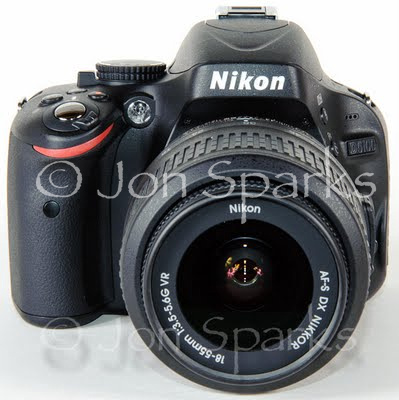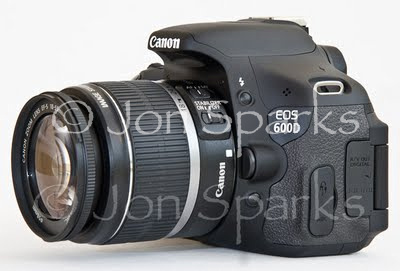



As I mentioned the other day, I’ve spent the last couple of months working intensively first with the Canon EOS 600D and then the Nikon D5100, preparing Expanded Guides to both of them. This came about purely by chance, thanks to the vagaries of camera manufacturer's product cycles, plus Ammonite having a small hiatus in authorship of the Canon books.
These cameras are direct competitors, both positioned one step up from the entry point of their ranges. It's been fascinating to have such a direct comparison, and also to have a chance to really get to know a Canon after 20 years as a Nikon user, the last seven with a range of digital SLRs.
Well, if you’re expecting any grand statements, let alone a Road-to-Damascus moment where I realise I need to change to Canon… don’t bother reading any further. In fact my firmest conclusion is that neither of these cameras is ideal for me. Let me enlarge on that briefly before looking at them side-by-side.
I could list various ‘pro’ features that these cameras lack, suggest that the maximum shooting rate isn’t fast enough for serious action, and so on, but for me the biggest frustration about these cameras is the fact that, in the name of making things simpler, they make some basic operations more complicated. This is mostly down to the fact that they only have one command dial and only one screen. Both my day-to-day DSLRs, the Nikon D700 and D7000, have two command dials and a secondary LCD on the top plate which is used for shooting settings.
The lack of a second command dial is most obvious when shooting in Manual mode. I know that the D5100 and 600D probably aren’t aimed at photographers who’ll use Manual all that much, but I’m talking about my personal reaction here. Though it also occurs to me, if you make Manual harder to use, people will use it less. And then someone marketing twerp'll say “see, there’s no demand for it”.
Using Manual on the the D700 and D7000 (and higher Canon models too), one dial controls shutter speed and one controls aperture. Direct. Simple, Fast. Intuitive. On the the D5100 and 600D the single command dial controls shutter speed; you have to press another button before you can use the same dial to change the aperture. It’s not that hard once you get used to it, but it just isn’t as slick, and you definitely can’t adjust aperture and shutter speed simultaneously.
Changing settings on a dedicated LCD is instant, whereas on both my ‘test’ cameras you have to press an extra button just to get to a screen where you can change things, and then scroll around that screen to get to the specific setting you want. Again it slows things down and to me would seem to discourage users from getting involved with the full range of options that the the D5100 and 600D both, very capably, provide.
The other specific issue I’d mention is changing ISO. The EOS 600D does have a dedicated ISO button, but it only takes you to a menu-style screen rather than one-touch ISO adjustment with the command dial. You certainly can’t set ISO with the camera to your eye. The D5100 doesn’t even have an ISO button, unless you re-program the Fn button to act as one. I’d certainly do this if I were using the camera long-term (in fact I’ve already posted it back).
This is regrettable because being able to change the ISO at will is one of the greatest advantages of digital over the (good?) old days of film. With film, once you’d loaded Velvia or whatever, you only had two fundamental camera controls, shutter and aperture. With digital you have a third leg to the tripod, ISO. Anything, however slight, that discourages people from making full use of all three controls is to be regretted.
Anyway, enough of my gripes about common failings of both cameras. What about how they fare when they go head to head?
Starting with first impressions: the Nikon is better-looking. I don’t think it’s all down to that smiley red flash on the hand grip either. I just prefer the slightly less rounded styling.
More importantly, the Nikon feels better in the hand. It definitely has a more solid feel to it, though that’s not because it’s heavier; in fact according to makers’ own figures the D5100 is 10 grams lighter. The D5100’s hand-grip is more positive too (at least for my hands, which are on the large side). Personally I prefer Nikon’s conventionally-shaped but well-sized and positive control buttons to Canon’s odd-shaped cluster on the back of the camera. I think design has got the better of function here.
In use, both are very competent cameras which can deliver excellent results in most conditions. Most of the time there’s very little to choose between them. If you want to drill down to the very last minutia then take a look at the reviews on the always-excellent dpreview: the EOS 600D is here and the Nikon D5100 is here.
Looking at the photos I took with the two cameras there’s still little to differentiate them. I don’t think there’s a killer feature that would make anyone switch from one brand to the other. However, there are some operational specifics that might swing it for you in the (unlikely?) event that you’re a discerning buyer who knows a good deal about photography but isn’t tied to either system by existing lenses. In no particular order:
The EOS 600D has a depth of field preview button; the D5100 doesn’t. On 35mm cameras this would have been a big difference; on digital it’s less significant because you can assess depth of field either through image playback or through Live View (see below). Still, point to Slytherin.
Sticking with depth of field, the EOS 600D has Canon’s A-DEP mode, which aims to set both focusing distance and aperture to ensure everything appears sharp. It’s a nice feature, especially for landscapes, but it’s more limited than they would like to admit. it assesses the depth of field required by using the 9 focus points. If there are nearer or more distant objects which don’t happen to line up with any of the focus points these will not be taken into account, and in the average landscape shot it’s very possible for there to be stuff in the frame at closer distances than any of the focus points are covering. Half a point to Slytherin.
On the other hand, the D5100 has a new HDR (high dynamic range) mode. This works by combining two separate shots with different exposures, one for the shadows and one for the highlights. And it does work; I took several shots with it that would have been impossible in a single exposure any other way. It still has limitations – only two source images, maximum exposure difference 3Ev – but still, a handy innovation on occasion. Point to Gryffindor.
If you’ve been reading my previous posts you’ll know I’ve gone from being a Live View sceptic to using it by choice for certain subjects. Both cameras have clear, bright, articulating screens which are a real benefit when using Live View. Both have the hinge on the left side, unlike the earlier Nikon D5000 which had it at the bottom – a fundamentally dumb thing to do when Live View is often at its best with the camera on a tripod (and movie shooting even more so). But there are some pretty big differences in the way Live View operates.
The Canon gives you an immediate and very clear depth of field preview in Live View – just press the button. The Nikon also gives you a preview but it works in a much quirkier and less intuitive way – I’ve already mentioned this in a previous post. Canon’s ‘final image simulation’ puts its nose in front.
However, the Nikon has much better autofocus in Live View (and movie shooting). It’s still not great for moving subjects and for really fast action you can forget it – but it’s well ahead of the Canon. For Live View overall, call it a dead heat. For movies, because of its superior autofocus, the D5100 surges ahead – but if you’re really serious about shooting movies with a DSLR, get a D7000.
OK, those are the main things that come to mind. Anything else? The D5100 has an extensive Retouch menu and also a new Effects position on the mode dial which includes options like Color sketch and Selective color. To me these are gimmicks pure and simple, and if I wanted to mess my photos about I’d do it in Photoshop anyway – but if you want to do this sort of thing in-camera, the Nikon has far more to offer.
The Nikon also has a wider set of Scene modes. Both cameras have Portrait, Landscape, Close up, Sports and Night portrait, but Nikon also has Child, Night landscape, Party/indoor, Beach/snow, Sunset, Dusk/dawn, Pet portrait, Candlelight, Blossom, Autumn colours and Food. I’d love to know how much use these modes (hidden behind the SCENE positron on the mode dial) actually get from the average owner, but still, point to Nikon. On the other hand, Canon’s Creative Auto mode offers a flexibility (and therefore a potential learning experience) that none of Nikon’s Auto and Scene modes can quite manage. Point and a half to Canon.
Finally, the EOS 600D has one excellent feature, even though I’m willing to bet at least 95% of owners will never use it: wireless flash control. This is slightly ironic, as it was Nikon who pioneered wireless flash, but you have to step up to the D7000 or higher (or the D90, still listed though slightly greying at the temples) to be able to use the built-in flash as a commander unit in a wireless setup. The D5100 can work within a wireless setup but only if it’s physically connected to a commander-capable Speedlight. The EOS 600D even has an ‘Easy Wireless mode’, though it didn’t seem noticeably easier than standard wireless operation. Still, big fat point to Canon.
OK, totting up the points time. On the operational features that I’ve actually scored, I see that Canon comes out ahead. However, I think the Nikon’s better feel in the hand and tidier control layout might even things up. Anyway, it’s a pretty close-run thing overall and anyone who’s in the market for this kind of camera should be pretty pleased with either.
But, in the best reality show traditions, “there can only be one winner”. And the tie-break question is: what abbreviation do they use for Shutter Priority mode? Nikon’s is S. Canon’s is Tv. They’ve been doing it for donkey’s years but it is and always has been indefensibly daft.
Nikon win.
*I suppose I should have mentioned that the 600D has a higher megapixel number, but how many times to I have to say that really means nothing?



